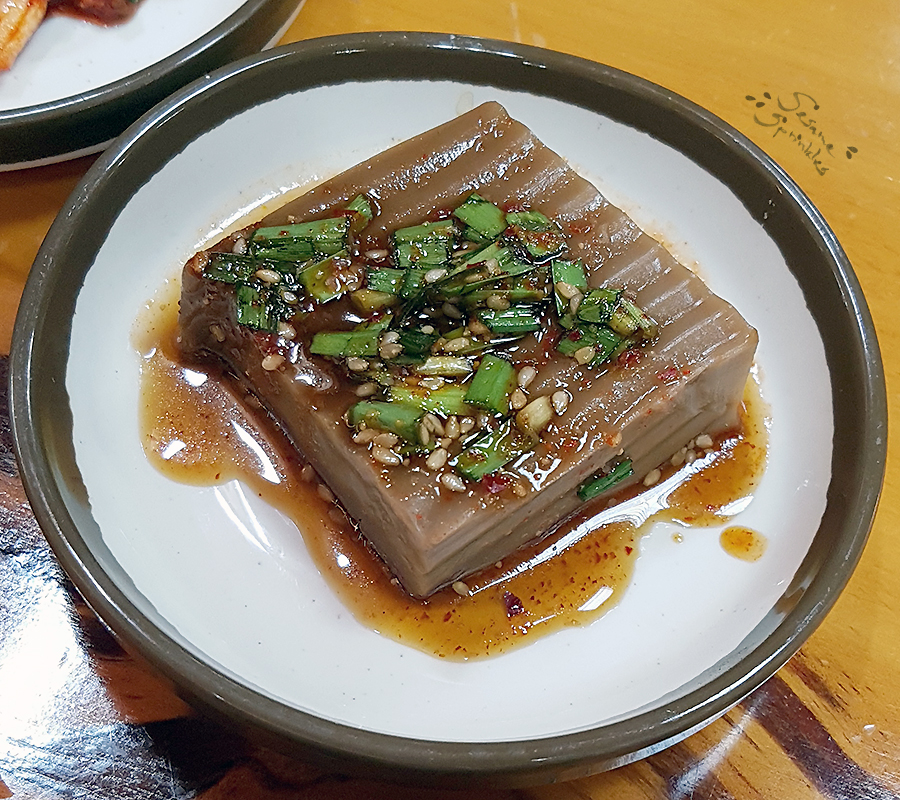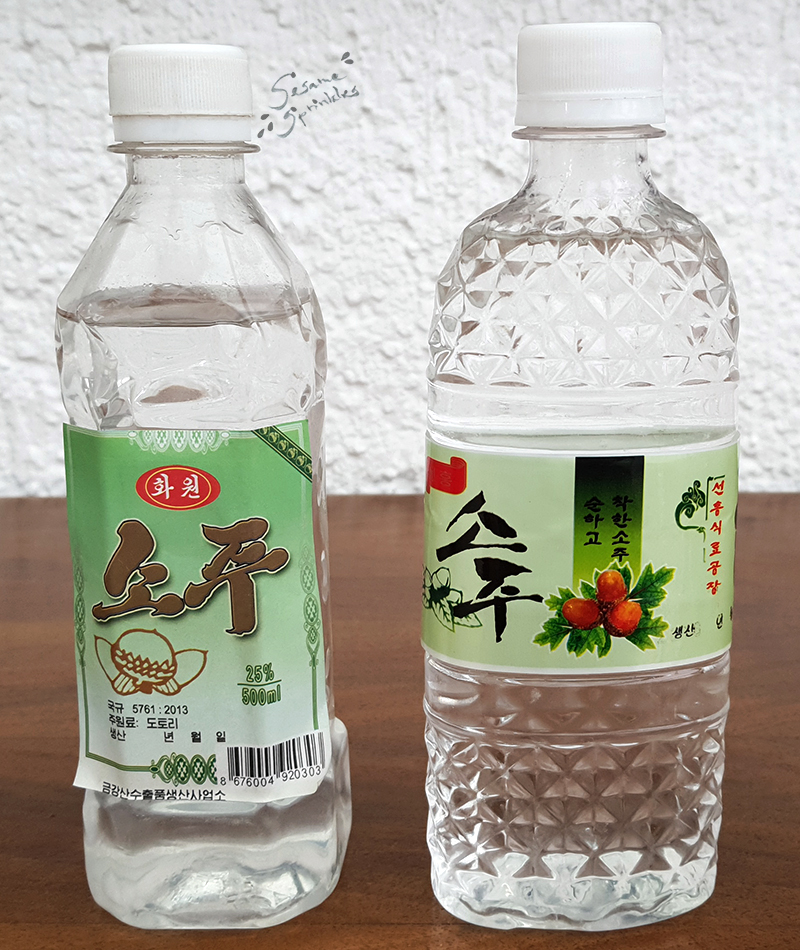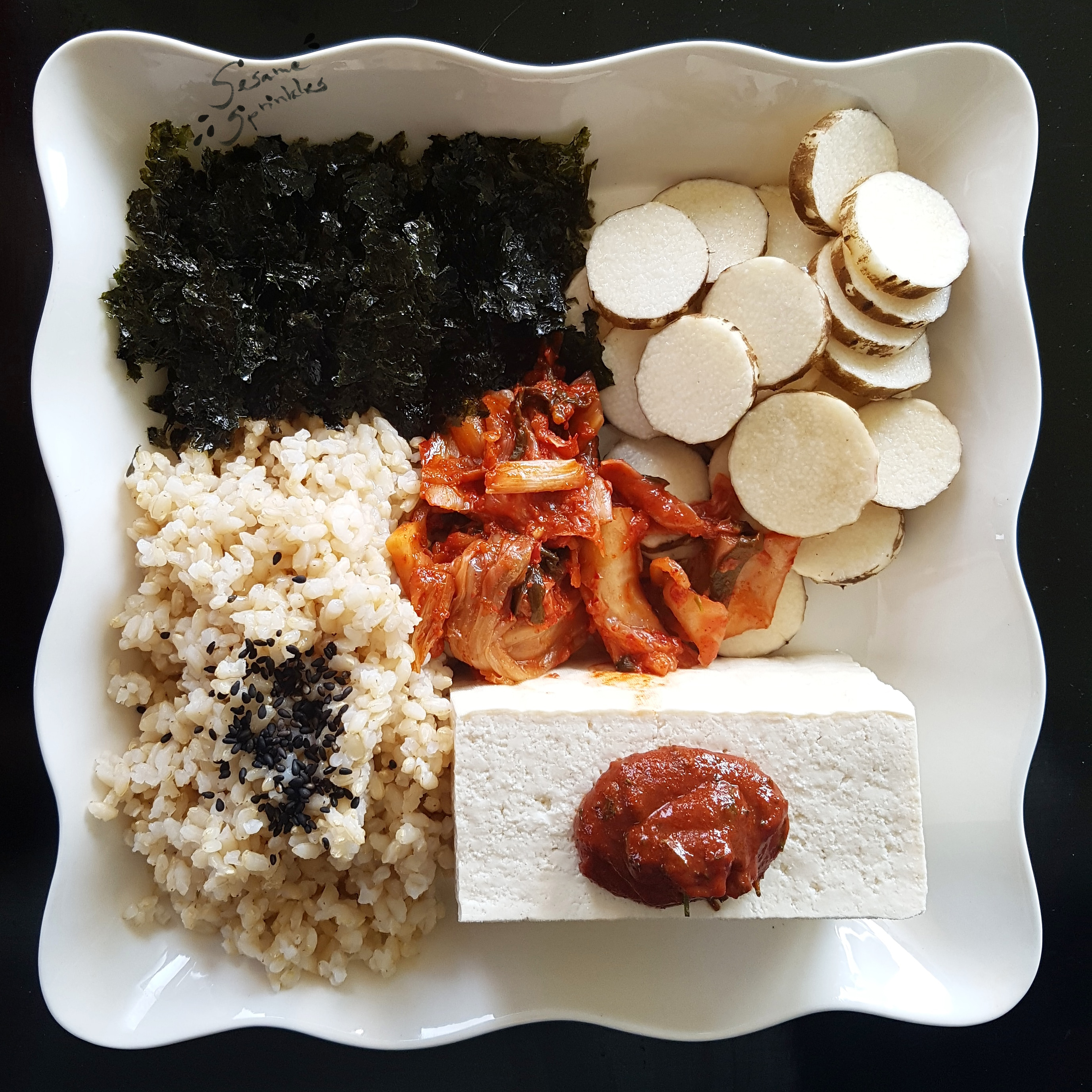Can you find a connection between squirrels, Romans and Koreans?
Here’s one:
Acorns.
Everyone knows that squirrels are fond of nuts, including those of the oak tree. 🌰🐿
Archaeologists and historians know that also humans have consumed acorns since ancient times. 🌰🏛
Who knew that at present, foods made from acorns are a significant ingredient in Korea’s eating and drinking culture? 🌰🇰🇷🇰🇵
Unlike squirrels, chipmunks and other wild animals who eat them raw, humans have to first process the nuts of oaks to make them palatable. Otherwise, fresh acorns taste rather unpleasant due to the tannins they contain. (Tannins are phytochemicals common in certain plants and can be perceived as bitterness or astringency.) Roasting acorns or washing acorns in several changes of water are a couple of methods for removing tannins and thus reducing their bitter taste.
Korean people, for instance, have invented this food item based on acorns:
Acorn jelly.

This is a brown-colored jelly made from acorns, water and a little bit of salt – no gelatin or other additives necessary. It’s vegan, gluten-free and wholesome! 🌱🚫🌾
The Korean name for acorn jelly is dotori-muk (도토리묵), in which dotori translates to “acorn” and muk denotes various types of plant-based jelly (a distinct group of foods). Dotori-muk is in fact the most common type of jelly in Korea, so sometimes the word “muk” refers to acorn jelly already.
Traditionally, dotori-muk is made by grinding peeled oak nuts and soaking them in water. Once the suspended particles have settled, the watery part is drained and fresh water is added. This process is repeated multiple times to wash out the tannins. Ideally, the resulting paste contains a minimum of tannins and consists mostly of starch. When the watery acorn mass is heated properly, the starch acts as a thickening agent: The liquid first transforms into a gel, which solidifies into jelly after cooling. Eventually, the resulting jelly can be cut into pieces and is used in a variety of dishes.


Overall, the traditional method is quite time-consuming and labor intensive. Thankfully, dotori-muk can be made more easily today, because processed acorn starch is available e.g. in Korean supermarkets. This “acorn jelly flour” aka dotori-muk garu (도토리묵가루) is simply mixed with water and then cooked into pudding. Note that acorn jelly and acorn flour are not made from pulverized acorns but from acorns which are leached of the tannins first. Otherwise the tannins of the oak would make food extremely bitter and astringent.
How do you eat acorn jelly? What does it taste like?
In theory, you can eat acorn jelly as it is. It will taste slightly bitter and rather bland, though. Hence, acorn jelly is best enjoyed in combination with seasonings, most frequently a sauce or dressing. [Find examples for dishes with acorn jelly below. 👇] Dotori-muk on its own has a distinct flavor due to the acorns, which may be described as “nutty” but it is different from the deep or fragrant aroma of e.g. roasted nuts.
Apart from that, an important aspect of acorn jelly is its texture! As the name implies, it has a jelly-like consistency which is soft yet bouncy. However, acorn jelly does not melt in your mouth like some other jellies, and it is slightly chewy (yet, less chewy than gelatin or gonyak!). It’s not slimy, but slippery and smooth.
Korean words that describe the texture concisely are yadeul-yadeul (야들야들하다) and taengeul-taengeul (탱글탱글하다).
So how do you eat acorn jelly?
If you are self-confident, you can try to pick up pieces of acorn jelly with chopsticks. 🥢 Just be aware that this skill is difficult to master: Grip too hard and the jelly breaks apart. 💔 Be too light and the jelly either keeps slithering away on the plate or it slips out of your hold in mid-air… 🐌
After all, the safest approach to eating acorn jelly is using a spoon. 🥄
Common dishes featuring Korean acorn jelly
There are several uses for acorn jelly! In general, Koreans use dotori-muk in savory dishes and not for dessert [contrary to jello or other types of pudding in Western cultures].
The easiest way to eat acorn jelly is this: Dotori-muk garnished with a seasoning sauce. Most frequently, the seasoning is based on soy sauce mixed with other ingredients such as chili powder, scallions or garlic chives, sesame seeds and roasted sesame oil; a versatile sauce referred to as yangnyeom ganjang (양념간장). It’s a veggie-friendly side dish (banchan 반찬) in Korean restaurants, and it’s easy to make at home if you have acorn jelly at hand. Simply top it with your preferred choice of sauce or other seasonings.



A signature dish featuring acorn jelly is dotori-muk muchim (도토리묵무침; mukmuchim 묵무침), which is comparable to a salad: Pieces of acorn jelly are mixed with fresh vegetables and seasoning. The dressing may be based on soy sauce once again, but besides the usual seasonings, vinegar or maesil syrup is often added to create a refreshingly sour, slightly sweet and salty flavor. This dish is normally vegan by default 🌱 and it can be made gluten-free if gluten-free soy sauce is used. Korean acorn jelly salad is available as a main dish at some restaurants or offered as an anju at Korean-style pubs. In general, it is a plant-based and wholesome food option – particularly when served as anju, i.e. food enjoyed while drinking alcoholic beverages and typically greasy and rich.
There are more dishes using dotori-muk, e.g. acorn jelly in soup, referred to as dotori-mukbap (도토리묵밥), dotori-muk sabal (도토리묵사발; short: muksabal 묵사발) or dotori-muk guksu (도토리묵국수). In a large bowl, thick strips of acorn jelly are garnished with toppings (e.g. raw vegetables, seaweed, kimchi and egg) and a broth is poured over it. This dish is sometimes combined with rice and served either warm or cold. Especially during the summer months, cold muksabal is a refreshing dish in Korea’s summer heat. ⚠️ However, these dishes often contain invisible animal-based ingredients such as anchovy broth (멸치육수) or kimchi with fish sauce. 🐟
In some cases, acorn jelly is used as the topping on bibimbap, which then correspondingly may be called dotori-muk bibimbap (도토리묵비빔밥).




Apart from that, Korean acorn jelly is the base for dotori-muk mallaengi (도토리묵말랭이) also known as geon-dotori-muk (건도토리묵) which literally means “dried acorn jelly”. First, acorn jelly is cut into strips, and then left to dry in the sun until it is hard, wrinkly and flat. This makes dotori-muk storable for a long period as well as better for transport. When it’s time to eat geondotori-muk, they only need to be soaked in water before consumption. The rehydrated pieces of jelly have a chewier texture and a wrinkly surface. They are also slightly tougher and less delicate than fresh acorn jelly, so they can be used in other types of cooking, e.g. stir-fries.


Where can you find acorn jelly? How do you make acorn jelly?
If you are in Korea, it is easy to get acorn jelly! Most Korean supermarkets nowadays offer acorn jelly packaged in plastic. On traditional markets, there is always at least one vendor specializing in acorn jelly and other types of muk [often also tofu!]. The jellies there have likely been made fresh on location, and you can purchase them by the block or bowl. A piece of hand-made jelly, which costs between 2000-5000 KRW on average, is then carefully wrapped into plastic bags. 💲 It is also possible to find acorn jelly being sold by the roadside by street vendors, although this has become a rare sight in Seoul.


Outside Korea, you can make acorn jelly yourself – if you have access to the essential ingredients, that is!

If you possess acorn jelly powder, which is basically starch of leached acorns, you can turn it into jelly. Following the instructions of the manufacturer, you normally add water and salt, and heat it while stirring constantly.* When the liquid has thickened evenly and becomes slightly darker or translucent, you pour it into bowls or square containers, in which it slowly cools down.
Alternatively, you could attempt making acorn jelly from scratch with the traditional technique. [There are several tutorials (in Korean) online.] Be aware that there exist several species of oaks and consequently also many different kinds of acorns! In Korean food culture, acorns from the native oak trees (e.g. Quercus serrata, Quercus dentata, Quercus acutissima) are used for acorn jelly and consequently tested safe for consumption.
In present South Korea, most common seems to be the sawtooth oak (Quercus acutissima), which is called Cham-namu (참나무) or Sangsuri-namu (상수리나무) in Korea. Its fruits, which are acorns, are occasionally referred to as sangsuri (상수리). But in general, acorns or oak nuts are simply called dotori (도토리), without specifying which kind of oak tree they came from.
By the way, fresh acorn jelly can be stored for up to a week. It is suggested to store acorn jelly in a cool and shady place for 3 or 4 day – not inside the fridge! The jelly tends to stiffen in the fridge and thus loses its typical “bounce”. While you can soften stiff dotori-muk by putting it into warm water or briefly blanching it, the original texture may not return completely. ♨️
Another fun fact is that in recent years, acorn jelly has become popular among health conscious Koreans as well as dieters. Compared to its volume and weight, acorn jelly is low in calories and has a high water content, which is why it is considered to help with weight loss. Some dieting people accordingly consume dotori-muk as a light alternative to dishes with rice and regular noodles, hoping to loose weight. 👙🩲⛱

Regardless of diet trends and food fads, dotori-muk is ideal for the summer! 🌞 Served cold with a simple sauce, as acorn jelly salad, or swimming in chilled broth, dotori-muk is the key ingredient in Korean foods associated with summertime. 🥗❄️🥣 Fall is the season for harvesting oak nuts 🍂🌰, but it is great to enjoy cold dishes made from acorn jelly during the warmer months of the year. 😎🌰🍮
Besides acorn jelly, there are other starchy foods such as noodles or savory pancakes which are likewise made from acorn meal.
Acorns can even be used to make alcohol, which is particularly the case in North Korea and its acorn soju (dotori soju 도토리소주).** 🇰🇵🍶




To conclude, acorns are a food source for wildlife as well as for humans! Oak nuts contain nutrients from carbohydrates, proteins and fats as well as minerals. But special techniques for making acorns edible are required, and knowledge of how to make acorn foods taste good.
People in South Korea as well as North Korea have found various ways to incorporate acorns into the local cuisine: Acorn foods are consumed as the main meal, as a simple side dish, acorn jelly is served together with drinks, and acorns can be enjoyed in liquid form as alcohol. 🥗🍶

.
.
Additional notes from the author
*) Especially the proportions of water to acorn starch are key to making jelly with a desirably tender and bouncy consistency.
**) Being one of the most consumed liquors on the Korean peninsula, soju is produced from a diversity of starchy ingredients. While mainly rice, barley, wheat, potato or sweet potato are used by South Korean companies, oak nuts are a common base in North Korea.
- alternative spellings: dotorimuk | dotori muk | jelly from acorns | oak nut jelly | acorn pudding | dotorimuk-muchim | dotori-muk muchim | dotori muk muchim | muksabal | muk sabal |
- compare to: mung bean jelly \ nokdumuk | nokdu-muk | 녹두묵 | cheongpomuk | cheongpo-muk | 청포묵 | water chestnut jelly \ olbang-gaemuk | olbanggaemuk | olbanggae-muk | olbang-gae-muk | 올방개묵 | buckwheat jelly | memilmuk | memil-muk | 메밀묵 | umuk | u-muk | umu \ 우묵 | 우뭇가사리 |















Thank you for the excellent article. I’m interested in learning more about the historic use of acorns by native Korean societies. Were they utilized as a staple by Koreans in the same way native Americans used them? Do you know of any resources that discuss this? Thank you!
LikeLike
Dear Noah,
thank you for your kind comment and the great question! 🙂
According to the Encyclopedia of Korean Culture, acorns are actually not mentioned as a staple but rather as a kind of emergency food in historic records! There are a couple of instances in which acorns helped feed the people during famines, e.g. under King Chungseon 충선왕 (story in Goryeosa 고려사) and under King Sukjong 숙종왕. Documents from late Joseon dynasty (e.g. 산림경제, 목민심서) also discuss this.
Source: http://encykorea.aks.ac.kr/Contents/Item/E0015896
LikeLike
Wow excellent, thank you so much for the help! Always learn something new from you.
LikeLiked by 1 person
You’re more than welcome! 😊 I enjoyed looking it up and also learned something new while doing it! 🤓 Feel free to ask anytime!
LikeLike